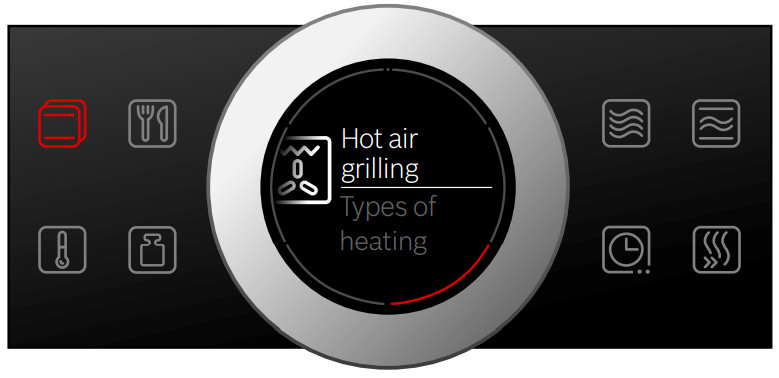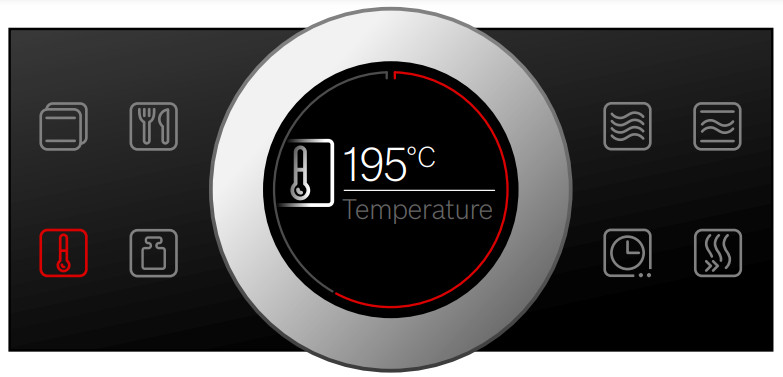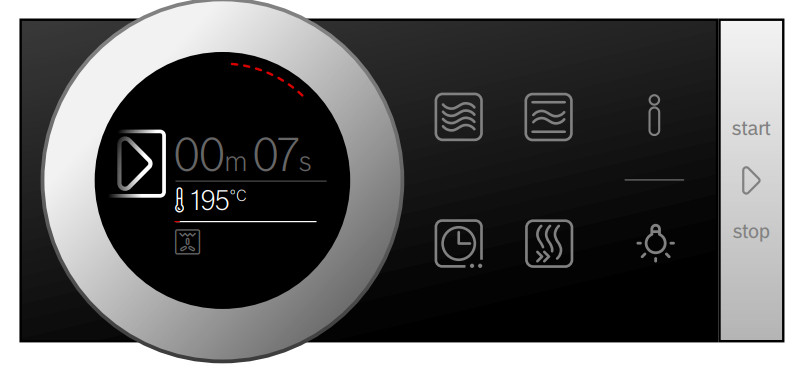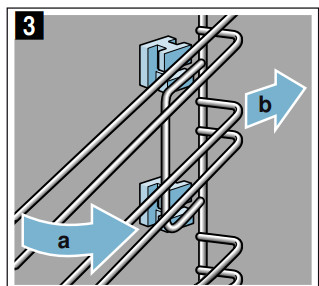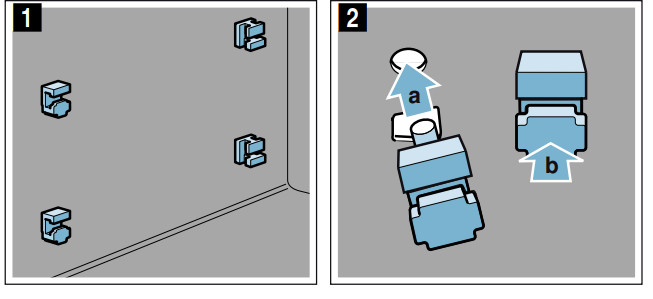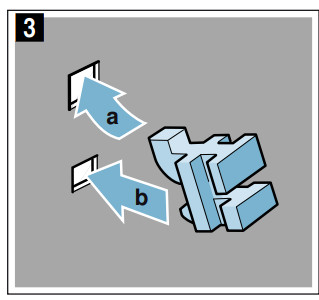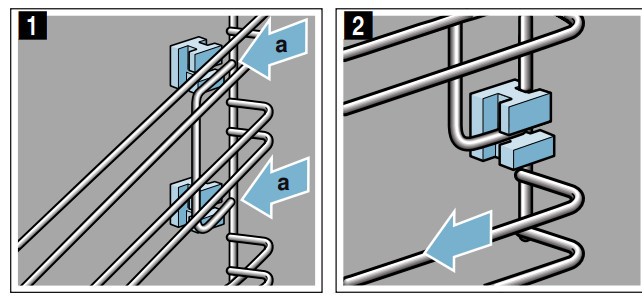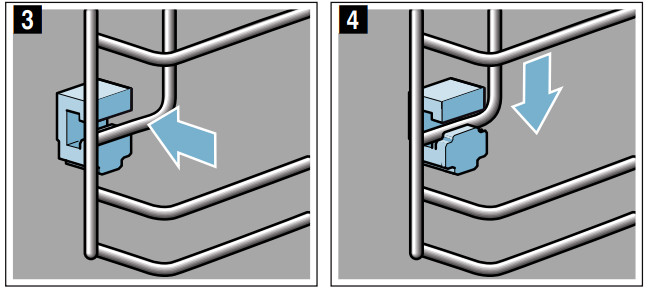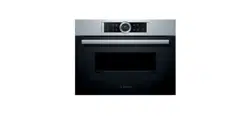Documents: Go to download!
User Manual
- User Manual - (English)
- User Manual - (English)
- Supplementary Documentation - (English)
- Supplementary Documentation - (English)
- Product Information - (English)
- Installation Instruction - (English)
- Causes of damage
- Environmental protection
- Getting to know your appliance
- Accessories
- Operating the appliance
- Microwave
- Childproof lock
- Basic settings
- Cleaning agent
- Rails
- Trouble shooting
Table of contents
User Manual Built-in oven
Causes of damage
General information
Caution!
- Accessories, foil, greaseproof paper or ovenware on the cooking compartment floor: do not place accessories on the cooking compartment floor. Do not cover the cooking compartment floor with any sort of foil or greaseproof paper. Do not place ovenware on the cooking compartment floor if a temperature of over 50 ºC has been set. This will cause heat to accumulate. The baking and roasting times will no longer be correct and the enamel will be damaged.
- Aluminium foil: Aluminium foil in the cooking compartment must not come into contact with the door glass. This could cause permanent discolouration of the door glass.
- Water in a hot cooking compartment: do not pour water into the cooking compartment when it is hot. This will cause steam. The temperature change can cause damage to the enamel.
- Moisture in the cooking compartment: Over an extended period of time, moisture in the cooking compartment may lead to corrosion. Allow the cooking compartment to dry after use. Do not keep moist food in the closed cooking compartment for extended periods of time. Do not store food in the cooking compartment.
- Cooling with the appliance door open: Following operation at high temperatures, only allow the cooking compartment to cool down with the door closed. Do not trap anything in the appliance door. Even if the door is only left open a crack, the front of nearby furniture may become damaged over time. Only leave the cooking compartment to dry with the door open if a lot of moisture was produced whilst the oven was operating.
- Fruit juice: when baking particularly juicy fruit pies, do not pack the baking tray too generously. Fruit juice dripping from the baking tray leaves stains that cannot be removed. If possible, use the deeper universal pan.
- Extremely dirty seal: If the seal is very dirty, the appliance door will no longer close properly during operation. The fronts of adjacent units could be damaged. Always keep the seal clean.
- Appliance door as a seat, shelf or worktop: Do not sit on the appliance door, or place or hang anything on it. Do not place any cookware or accessories on the appliance door.
- Inserting accessories: depending on the appliance model, accessories can scratch the door panel when closing the appliance door. Always insert the accessories into the cooking compartment as far as they will go.
- Carrying the appliance: do not carry or hold the appliance by the door handle. The door handle cannot support the weight of the appliance and could break.
Microwave
Caution!
- Creation of sparks: Metal – e.g. a spoon in a glass – must be kept at least 2 cm from the cooking compartment walls and the inside of the door. Sparks can irreparably damage the glass on the inside of the door.
- Combining accessories: Do not combine the wire rack with the universal pan. Sparks may be created if they are inserted directly on top of one another. Only insert them into their own shelf level.
- Microwave only: The universal pan and baking tray are unsuitable when using the microwave only. If you use either of these, this may create sparks, which may damage the cooking compartment. Place cookware on the wire rack provided, or place it in the microwave and set a type of heating.
- Foil containers: Do not use foil containers in the appliance. They damage the appliance by producing sparks.
- Operating the microwave without food: Operating the appliance without food in the cooking compartment may lead to overloading. Never switch on the microwave unless there is food inside. The short crockery test is the exception to this rule. ~ "Microwave" on page 18
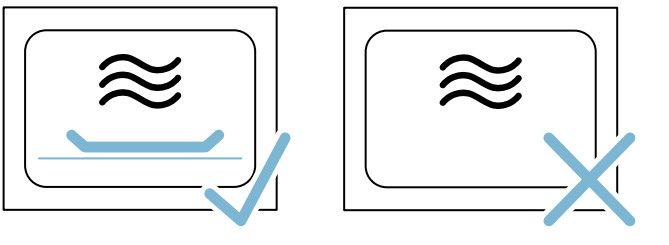
- Microwave popcorn: Never set the microwave output too high. Use a maximum microwave output of 600 watts. Always place the popcorn bag on a glass plate. The door panels may jump if overloaded.
Environmental protection
Saving energy
- Only preheat the appliance if this is specified in the recipe or in the tables in the operating instructions.
- Leave frozen food to defrost before placing it in the cooking compartment.
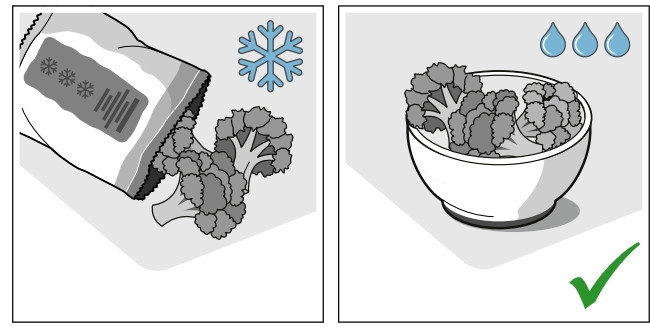
- Use baking tins that are dark-coloured, painted black or have an enamel coating. These absorb the heat particularly well.
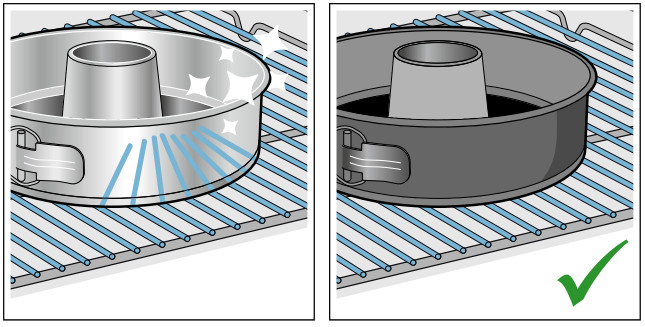
- Remove any unnecessary accessories from the cooking compartment.
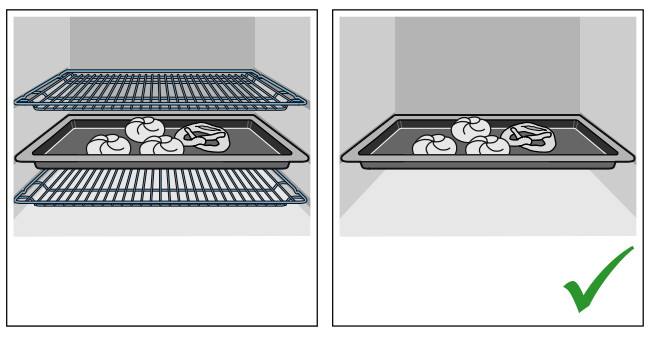
- Open the appliance door as infrequently as possible when the appliance is in use.
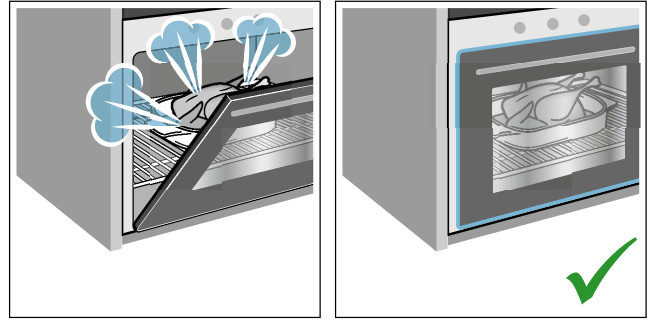
- It is best to bake several cakes one after the other. The cooking compartment stays warm. This reduces the baking time for the second cake. You can place two cake tins next to each other in the cooking compartment.
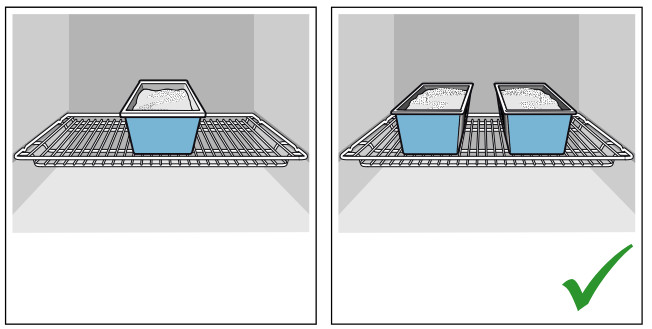
- For longer cooking times, you can switch the appliance off 10 minutes before the end of the cooking time and use the residual heat to finish cooking.
Environmentally-friendly disposal
Dispose of packaging in an environmentally-friendly manner. This appliance is labelled in accordance with European Directive 2012/19/EU concerning used electrical and electronic appliances (waste electrical and electronic equipment - WEEE). The guideline determines the framework for the return and recycling of used appliances as applicable throughout the EU
Getting to know your appliance
Get t i ng to know your appl i anc eIn this chapter, we will explain the indicators and controls. You will also find out about the various functions of your appliance.
Note: Depending on the appliance model, individual details and colours may differ.
Control panel
In the control panel, you can use the various buttons, touch fields and the rotary selector to set the different appliance functions. The current settings are shown on the display. The overview shows the control panel when the appliance is switched on with a selected heating type.
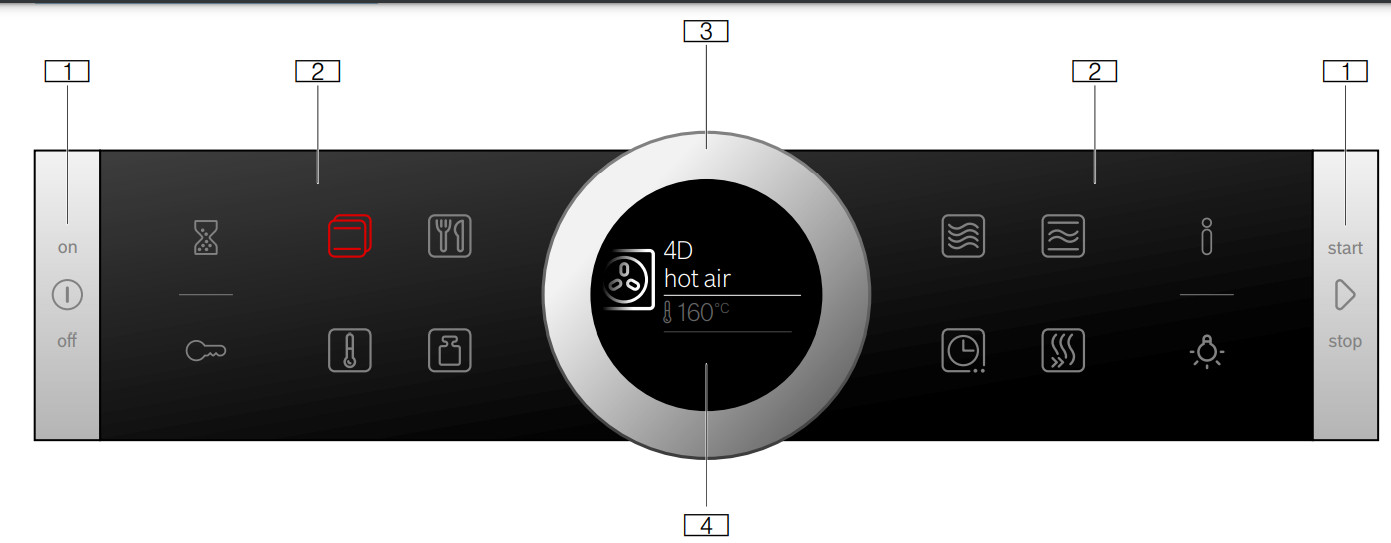
- Buttons
- The buttons on the left- and right-hand side of the control panel have a pressure point. Press these buttons to activate them. For appliances that do not have a stainless steel front, these two button touch fields do not have a pressure point.
- Touch fields
- There are sensors under the touch fields. Simply touch the respective symbol to select the function.
- Rotary selector
- The rotary selector is fitted so that you can turn it indefinitely to the left or right. Press it lightly and move it in the direction required using your finger.
- Display
- You can see the current adjustment values, options or notes in the display.
Controls
The individual controls are adapted for the various functions of your appliance. You can set your appliance simply and directly.
Buttons and touch fields
Here you can find a short explanation of the various buttons and touch fields.

External touch fields
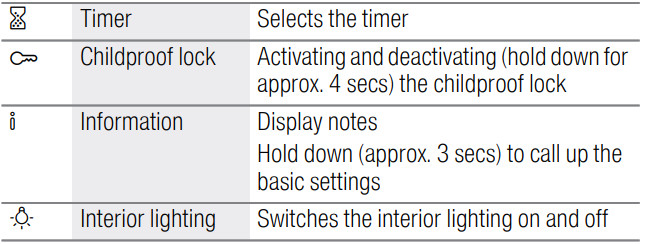
Internal touch fields
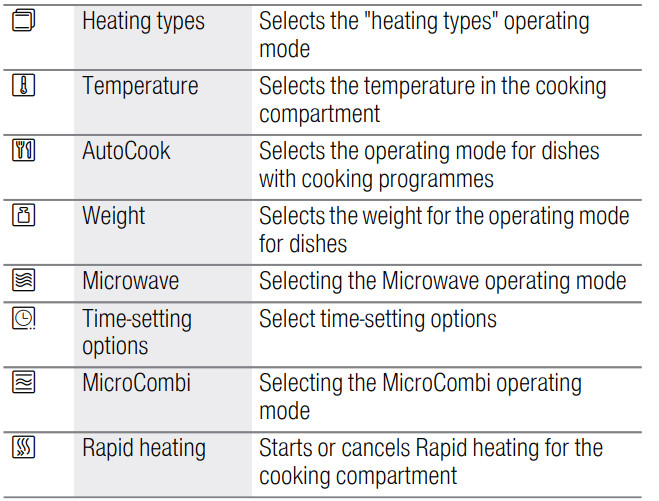
The touch field, which has a value on the display that can be changed or displayed in the foreground, lights up red.
Rotary selector
You can use the rotary selector to change the adjustment values shown on the display. In most selection lists, such as the temperature, you have to turn the rotary selector back the other way if you reach the minimum or maximum value. However, for the heating types for example, the first selection follows the last.
Display
The display is structured so that the information can be read at a glance in any situation. The value that you can currently set is highlighted. It is displayed in white lettering and underlined in white. The value in the background is displayed in grey text.
- Highlighted information
- The highlighted value can be changed immediately without first being selected. After starting an operation, either the temperature or level remains highlighted. The white line also serves as the heating line and gradually turns red.
- Note: When using the Microwave operating mode, the cooking time is highlighted. The heating line does not appear
- Enlargement
- As long as you use the rotary selector to change the highlighted value, only this value will be displayed larger.
Display ring
The display ring can be found around the outside of the display. If you change a value, the display ring shows you where you are in the selection list. Depending on the settings area and length of the selection list, the display ring may be continuous or divided into segments. During operation, the display ring turns red at secondlong intervals. After every full minute, the segments turn red again from the beginning. As the cooking time counts down, one segment disappears every second.
Temperature display
After the operation has started, the current cooking compartment temperature is displayed graphically on the display.
- Heating line
- The white line under the temperature turns red from left to right as the cooking compartment heats up. When you are preheating the appliance, the optimal time to place the food in the cooking compartment is when the line has completely turned red. For set levels, e.g. the grill setting, the heating line turns red immediately.
- Residual heat indicator
- When the appliance is switched off, the display ring shows the residual heat in the cooking compartment. As the residual heat cools down, the display ring becomes darker and disappears completely at some point.
Note: Due to thermal inertia, the temperature displayed may be slightly different to the actual temperature inside the oven.
Operating modes
Your appliance has various operating modes which make your appliance easier to use. You can find more precise descriptions of these in the corresponding sections.
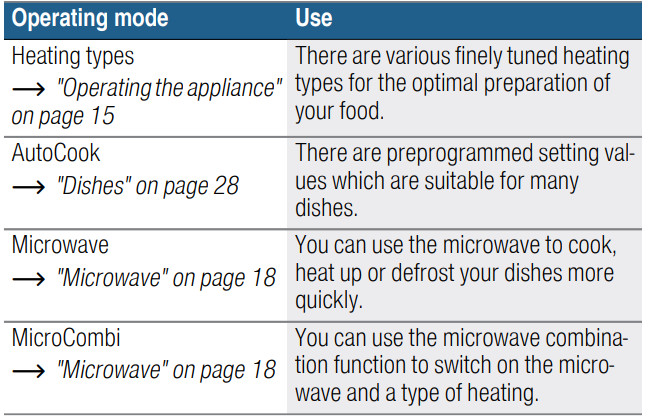
Types of heating
To enable you to find the correct type of heating for your dish, we have explained the differences and scopes of application here. The symbols for each type of heating help you to remember them.
When cooking at very high temperatures, the appliance lowers the temperature slightly after an extended period.
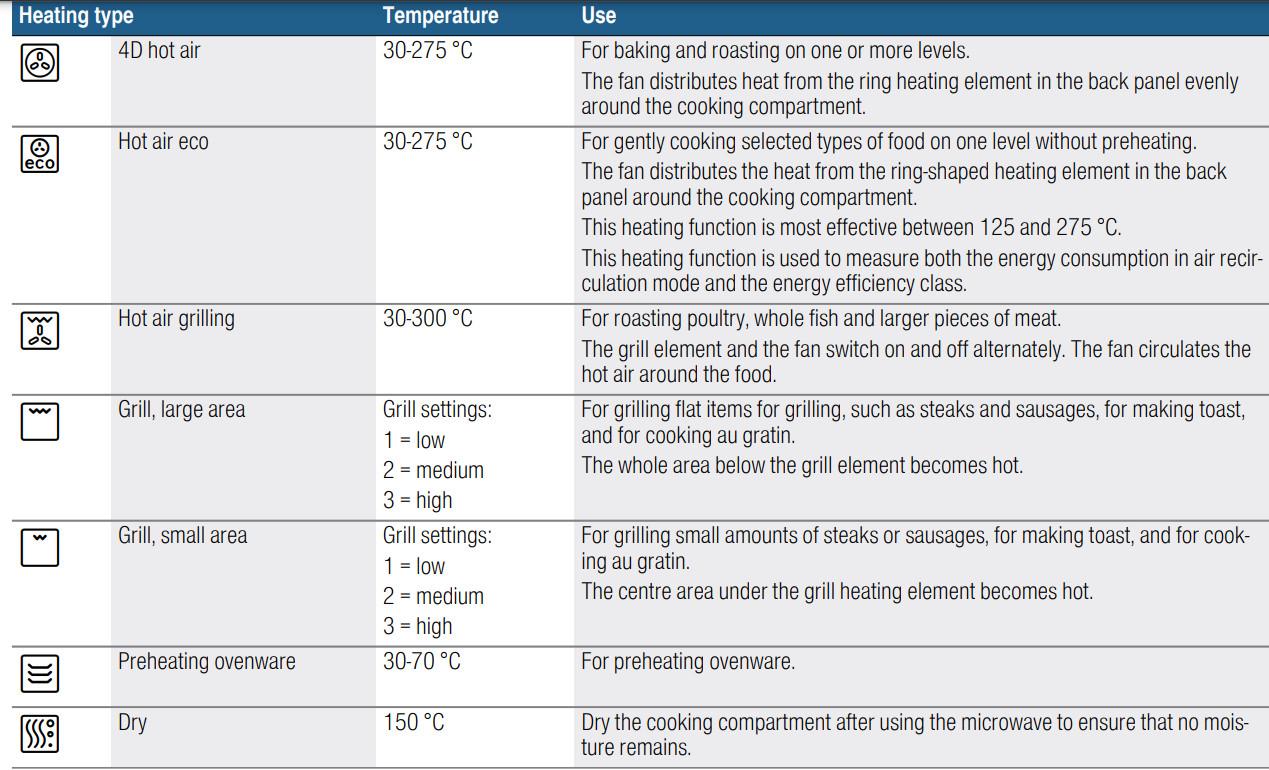
Default values
For each heating type, the appliance specifies a default temperature or level. You can accept this value or change it in the appropriate area.
Microwave
To ensure that you always use the correct microwave power setting, we have provided a general overview of what the different power settings can be used for below. The microwave power settings do not always correspond to the exact wattage that the appliance uses.

MicroCombi
Various types of heating can be combined with the Microwave operating mode. The appliance heats up and the microwave is switched on at the same time. As a result, the food is ready in a much shorter time. Microwave power settings between 90 and 360 watts are suitable for this.
Accessories
Accessories included
Your appliance is equipped with the following accessories:
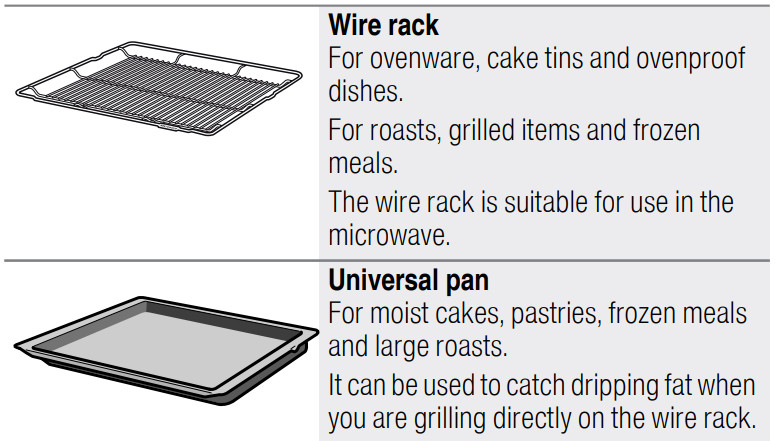
Only use original accessories. They are specially adapted for your appliance. You can buy accessories from the after-sales service, from specialist retailers or online.
Note: The accessories may deform when they become hot. This does not affect their function. Once they have cooled down again, they regain their original shape.
Microwave
Only the wire rack provided is suitable when using the microwave only. If you use the universal pan or the baking tray, this may create sparks, which may damage the cooking compartment. When using the appliance in combination with the microwave or "Dishes" mode, you can use the universal pan, baking tray or any other accessories that have been included with the appliance.
Inserting accessories
The cooking compartment has three shelf positions. The shelf positions are counted from the bottom up.
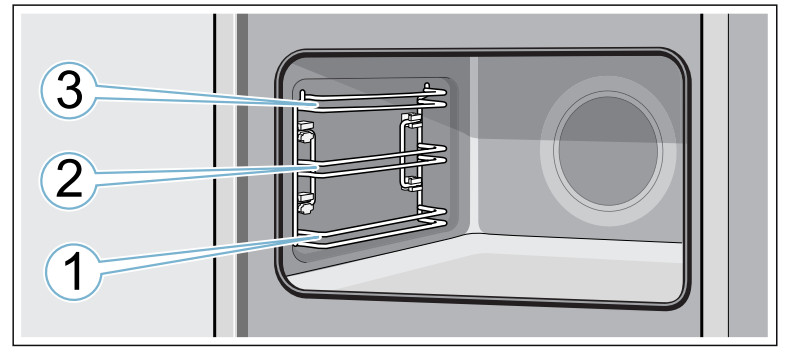
When using positions 1, 2 and 3, always insert the accessory between the two guide rods for a shelf position.
Notes
- Ensure that you always insert the accessories into the cooking compartment the right way round.
- Always insert the accessories fully into the cooking compartment so that they do not touch the appliance door.
Locking function
The accessories can be pulled out approximately halfway until they lock in place. The locking function prevents the accessories from tilting when they are pulled out. The accessories must be inserted into the cooking compartment correctly for the tilt protection to work properly.
When inserting the wire rack, ensure that the catch tappet a is at the rear and is facing downwards. The lettering "microwave" must be at the front and the outer rail must face downwards 
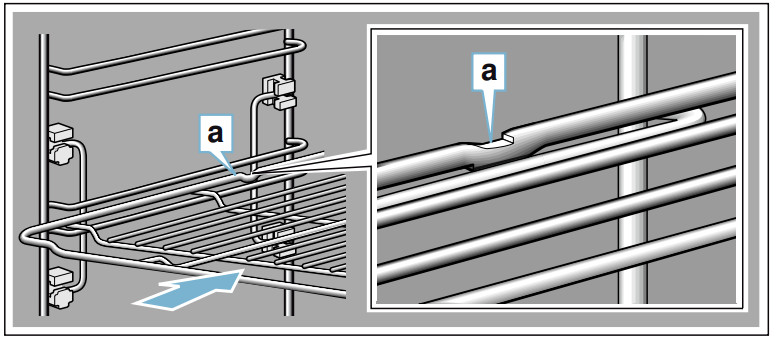
When inserting baking trays, ensure that the catch tappet ais at the rear and is facing downwards. The sloping edge of the accessory b must be facing forwards towards the appliance door.
Example in the picture: Universal pan
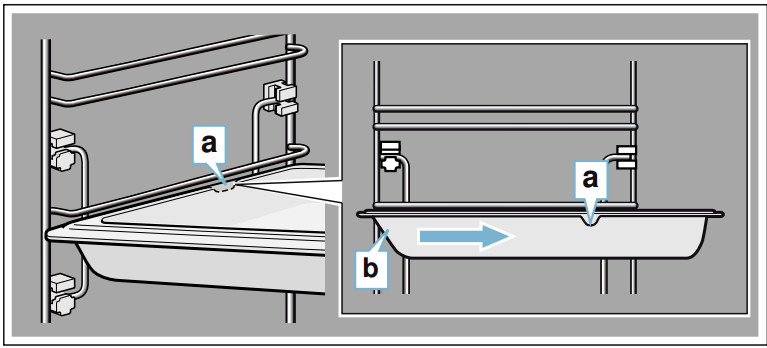
Optional accessories
You can buy optional accessories from the after-sales service, from specialist retailers or online. *You will find a comprehensive range of products for your appliance in our brochures and online. Both availability and whether it is possible to order online differ between countries. Please see your sales brochures for more details.
Note: Not all optional accessories are suitable for every appliance. When purchasing, please always quote the exact identification number (E-no.) of your appliance. ~ "Customer service" on page 27
Special accessories
- Wire rack
- For ovenware, cake tins and ovenproof dishes, and for roasts and grilled food.
- Universal pan
- For moist cakes, pastries, frozen meals and large roasts. It can be used to catch dripping fat when you are grilling directly on the wire rack.
- Baking tray
- For tray bakes and small baked products.
- Wire insert
- For meat, poultry and fish. For inserting into the universal pan to catch dripping fat and meat juices.
- Universal pan, non-stick
- For moist cakes, pastries, frozen meals and large roasts. Pastries and roasts can be removed more easily from the universal pan.
- Baking tray, non-stick
- For tray bakes and small baked products. The pastries can be removed more easily from the baking tray.
- Profi pan
- For preparing large quantities.
- Lid for the Profi pan
- The lid turns the Profi pan into a Profi roasting dish.
- Pizza tray
- For pizzas and large round cakes
- Grill tray
- Use for grilling in place of the wire rack or as a splatter guard.Only use in the universal pan.
- Bread-baking stone
- For home-made bread, bread rolls and pizzas that require a crispy base. The baking stone must be preheated to the recommended temperature.
- Glass roasting dish (5.1 litres)
- For stews and bakes. Particularly suitable for the "Meals" operating mode.
- Glass tray
- For large roasts, moist cakes and bakes.
- Glass tray
- For bakes, vegetable dishes and baked goods.
- Decorative trims
- For concealing the lower shelf of the unit and the base of the appliance.
Operating the appliance
Switching the appliance on and off
Before you are able to set the appliance, you must switch it on.
Note: The childproof lock and the timer can also be set when the appliance is switched off. Certain displays and notes, such as those relating to the residual heat in the cooking compartment, remain visible on the display after the appliance has been switched off. Switch off your appliance when you do not need to use it. If no settings are applied for a long time, the appliance switches itself off automatically.
Switching on the appliance
Press the  On/Off button to switch on the appliance. All touch fields light up red. The Bosch logo appears on the display, and then the first heating type in the selection list.
On/Off button to switch on the appliance. All touch fields light up red. The Bosch logo appears on the display, and then the first heating type in the selection list.
Note: In the basic settings, you can specify which operating mode should appear after the appliance is switched on. ~ "Basic settings" on page 21
Switching off the appliance
Press the  On/Off button to switch off the appliance. Any functions that may be running are cancelled. The time, or if applicable, the residual heat indicator, appears on the display.
On/Off button to switch off the appliance. Any functions that may be running are cancelled. The time, or if applicable, the residual heat indicator, appears on the display.
Note: In the basic settings, you can set whether the clock should be displayed when the appliance is switched off. ~ "Basic settings" on page 21
Starting the operation
You must press the  Start/Stop button to start each operation. After starting the appliance, the time display is shown on the display along with the settings. The display ring and the heating line also appear.
Start/Stop button to start each operation. After starting the appliance, the time display is shown on the display along with the settings. The display ring and the heating line also appear.
Pausing the operation
You can also interrupt and then continue an operation using the  Start/Stop button. If you press and hold the
Start/Stop button. If you press and hold the  Start/Stop button for approx. 3 seconds, the operation is cancelled and all settings are reset.
Start/Stop button for approx. 3 seconds, the operation is cancelled and all settings are reset.
Note: The fan may continue to run after an operation has been paused or cancelled.
Setting the type of heating and temperature
Touch the  field to select the types of heating. The symbol lights up red and the first type of heating appears in the display with a default temperature.
field to select the types of heating. The symbol lights up red and the first type of heating appears in the display with a default temperature.
Example in the picture:  Hot air grilling at 195 °C.
Hot air grilling at 195 °C.
- Turn the rotary selector to set the type of heating.
- Touch the
 field. The temperature is highlighted in white in the display.
field. The temperature is highlighted in white in the display. - Turn the rotary selector to set the temperature.
- Press the
 Start/Stop button to start. The time in the display shows how long the operation has already been running.
Start/Stop button to start. The time in the display shows how long the operation has already been running.
The appliance begins to heat up.
When your dish is ready, use the On/Off button to switch off the appliance.
Note: You can set both a cooking time and an end time for the operation on the appliance. ~ Page 16
Changing
After starting the appliance, the temperature is highlighted. When you move the rotary selector, the temperature is changed and applied immediately
Time-setting options
Your appliance has different time-setting options.
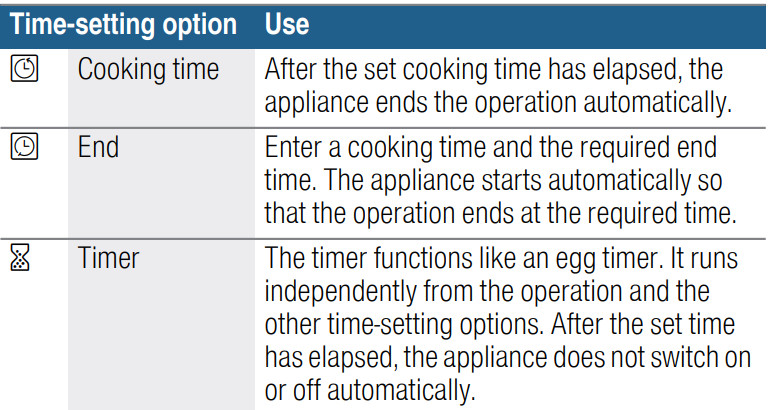
You can call up the cooking time and the end time after setting a operation using the  field. The timer has a separate
field. The timer has a separate  field and can be adjusted at any time. A signal sounds after a cooking time or timed period has elapsed. You can cancel the signal early by touching the
field and can be adjusted at any time. A signal sounds after a cooking time or timed period has elapsed. You can cancel the signal early by touching the  field.
field.
Note: You can change how long the signal sounds for in the basic settings. ~ "Basic settings" on page 21
Setting the cooking time
You can set the cooking time for your dish on the appliance. This means that the cooking time is not unintentionally exceeded and you do not need to interrupt other work in order to end the operation.
Setting
Depending on which direction you turn the rotary selector first, the cooking time starts at a particular default value: Left = 10 minutes, right = 30 minutes. The cooking time can be set in one-minute increments up to one hour, and then in five-minute increments. The maximum time that can be set is 23 hours and 59 minutes.
Example in the picture: Cooking time of 45 minutes.
- Set the operating mode and temperature or level.
- Touch the
 field before starting. The cooking time is highlighted in white in the display.
field before starting. The cooking time is highlighted in white in the display. - Turn the rotary selector to set the cooking time.

- The value is applied after a few seconds, or you can touch the
 field twice. The cooking time is shown in the display under the operating mode and temperature or level.
field twice. The cooking time is shown in the display under the operating mode and temperature or level.
- Press the
 Start/Stop button to start. The cooking time counts down in the display
Start/Stop button to start. The cooking time counts down in the display
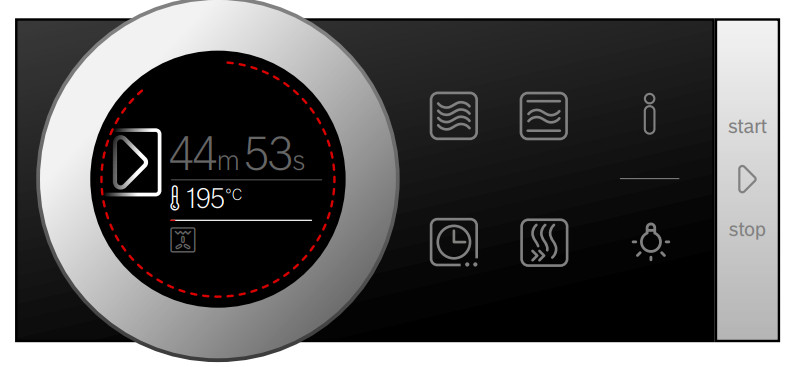
The appliance begins to heat up.
Once the cooking time has elapsed, an audible signal sounds. The appliance stops heating up. The cooking time 00 m 00 s is shown in the display.
You can use the  field to set another cooking time, or use the
field to set another cooking time, or use the  Start/Stop button to continue the operation without a cooking time.
Start/Stop button to continue the operation without a cooking time.
When your dish is ready, use the  On/Off button to switch off the appliance.
On/Off button to switch off the appliance.
Setting the end time
You can delay the time that the cooking time ends. You can, for example, put your dish in the cooking compartment in the morning and set the cooking time so that it is ready at lunch time.
Notes
- Ensure that food is not left in the cooking compartment for too long as it may spoil.
- Do not adjust the end time once the operation has started. The cooking result would no longer be satisfactory.
Setting
The end of the cooking time can be delayed by a maximum of 23 hours and 59 minutes. Example in the picture: The set cooking time is 45 minutes and you want the dish to be ready at 12.00 p.m.
- Set the operating mode and temperature or level.
- Set the cooking time.
- Before starting, touch the
 field once again. The end time is highlighted in white in the display.
field once again. The end time is highlighted in white in the display. - Turn the rotary selector to set a later end time.
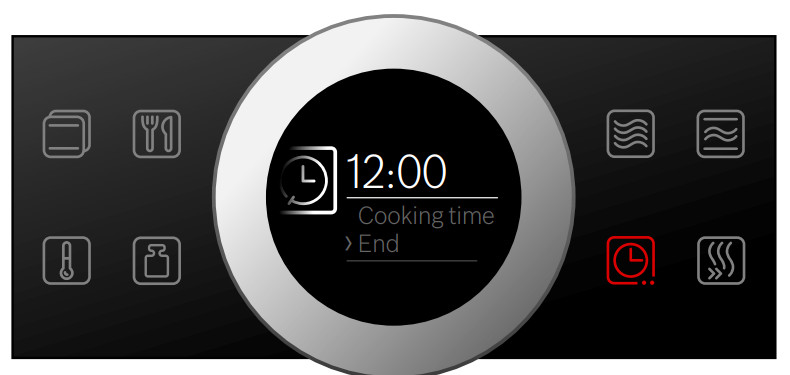
- The value is applied after a few seconds, or you can touch the
 field again. The end time is shown in the display under the operating mode and temperature or level.
field again. The end time is shown in the display under the operating mode and temperature or level.
- Press the
 Start/Stop button to start. The time at which the appliance will start is shown in the display.
Start/Stop button to start. The time at which the appliance will start is shown in the display.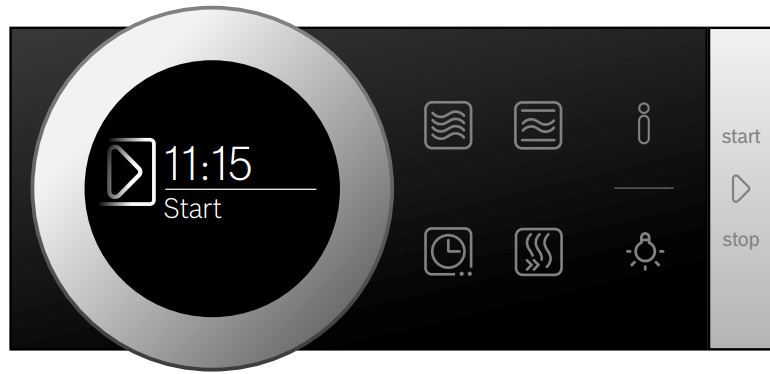
- The appliance is in standby mode. When the appliance starts, the cooking time counts down in the display. Once the cooking time has elapsed, an audible signal sounds. The appliance stops heating up. The cooking time 00 m 00 s is shown in the display. You can use the
 field to set another cooking time, or use the
field to set another cooking time, or use the  Start/Stop button to continue the operation without a cooking time. When your dish is ready, use the
Start/Stop button to continue the operation without a cooking time. When your dish is ready, use the  On/Off button to switch off the appliance.
On/Off button to switch off the appliance.
Setting the timer
The timer runs alongside other settings. You can set it at any time, even if the appliance is switched off. It has its own audible signal so that you can tell whether it is the timer or a cooking time which has elapsed.
Adjusting settings
The timer duration always starts at zero minutes. The higher the value, the greater the time steps when setting the timer. The maximum setting is 24 hours.
- Touch the
 field. The symbol lights up red. On the display, the timer duration is shown in white and in focus.
field. The symbol lights up red. On the display, the timer duration is shown in white and in focus. - Set the timer duration using the rotary selector.
- Press the
 field to start. Note: After a few seconds, the timer also starts automatically. The timer duration counts down.
field to start. Note: After a few seconds, the timer also starts automatically. The timer duration counts down.
The timer duration counts down. The timer remains visible on the display if the appliance is switched off. When an operation is running, the settings for this operation are shown in the foreground. When you touch the field, the timer duration is displayed for a few seconds. When the timer duration comes to an end, an audible signal sounds and a note appears on the display. The symbol is no longer lit up
field, the timer duration is displayed for a few seconds. When the timer duration comes to an end, an audible signal sounds and a note appears on the display. The symbol is no longer lit up
Tip: If the set timer duration relates to the appliance operation, use the cooking time. The time is visible in the foreground and the appliance switches off automatically.
Changing and cancelling
To change the timer duration, touch the  field. The timer duration is displayed in white and in focus, and can be changed by using the rotary selector. If you want to cancel the timer, reset the timer duration to zero. Once the change has been applied, the symbol is no longer lit up.
field. The timer duration is displayed in white and in focus, and can be changed by using the rotary selector. If you want to cancel the timer, reset the timer duration to zero. Once the change has been applied, the symbol is no longer lit up.
Microwave
You can use the microwave to cook, heat up or defrost food quickly. The microwave can be used on its own, or in combination with a type of heating. To ensure optimum use of the microwave, please observe the notes on cookware and familiarise yourself with the data in the application tables at the end of the instruction manual.
Cookware
Not all cookware is suitable for microwaves. To ensure that your food is heated and the appliance is not damaged, only use cookware that is suitable for microwaves. Heat-resistant cookware made of glass, glass ceramic, porcelain or heat-resistant plastic is suitable. These materials allow microwaves to pass through. You can also use ceramic if it has been fully glazed and has no cracks.
You can also use serving dishes. This saves you having to transfer food from one dish to another. You should only use cookware with decorative gold or silver trim if the manufacturer guarantees that they are suitable for use in microwaves.
To bake in combined operation, you can use ordinary metal baking tins. This means that the cake is also browned from below. Metal dishes are not suitable for other applications. Metal does not allow microwaves to pass through. Food in covered metal containers will remain cold.
Caution! Creation of sparks: Metal (e.g. a spoon in a glass) must be kept at least 2 cm from the cooking compartment walls and the inside of the door. Sparks may irreparably damage the glass on the inside of the door.
Cookware test
Never switch on the microwave unless there is food inside. The short cookware test is the only exception to this rule. Perform the following test if you are unsure whether your cookware is suitable for use in the microwave.
- Heat the empty cookware at maximum power for ½ to 1 minute.
- Check the temperature of the cookware during this time.
The cookware should remain cold or warm to the touch. The cookware is unsuitable if it becomes hot or sparks are generated. In this case, stop the test.
Warning – Risk of burns! The accessible parts become very hot when in operation. Never touch hot parts. Keep children at a safe distance.
Accessories included
Only the wire rack provided is suitable when using the microwave only. If you use the universal pan or the baking tray, this may create sparks, which may damage the cooking compartment. When using the appliance in combination with the microwave or "Dishes" mode, you can use the universal pan, baking tray or any other accessories that have been included with the appliance.
When using the microwave, it is best to insert accessories at level 1, unless otherwise specified.
Microwave power settings
A variety of microwave power settings that are suitable for different types of food and food preparation are available.
A cooking time must always be set to operate the microwave. You can either apply the default cooking time or adjust it in the relevant menu.
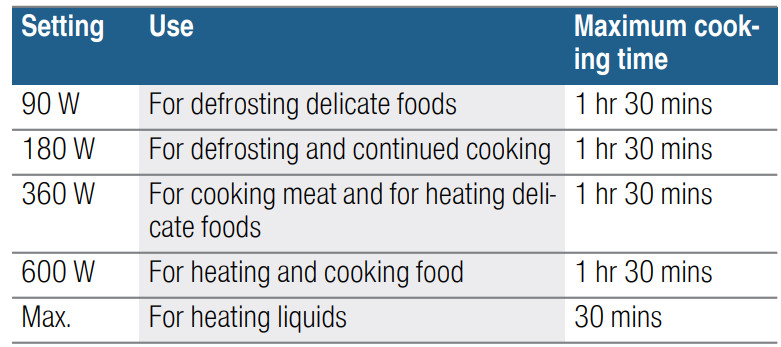
The maximum setting is designed for heating liquids only; it is not designed for heating food. To protect the appliance, the maximum power of the microwave is gradually reduced to 600 W during the first few minutes. Full power is made available again after a cooling period.
Setting the microwave
Before setting the microwave, observe the information regarding suitable ovenware.
- Touch the
 field. The microwave power setting is highlighted in white in the display.
field. The microwave power setting is highlighted in white in the display. - Turn the rotary selector to set the microwave power setting.
- Touch the
 field. The cooking time is highlighted in white in the display.
field. The cooking time is highlighted in white in the display. - Turn the rotary selector to set the cooking time.
- Press the
 Start/Stop button to start.
Start/Stop button to start.
The cooking time counts down in the display. The heating line does not appear when using the microwave operating mode.
The appliance starts.
Once the cooking time has elapsed, an audible signal sounds. The appliance finishes the operation. The cooking time 00 m 00 s is shown in the display.
When your dish is ready, use the  On/Off button to switch off the appliance.
On/Off button to switch off the appliance.
Note: If you open the appliance door while the appliance is in operation, this pauses operation. Once you have closed the door, you will need to press the Start/Stop button  to resume operation. If you have altered the basic setting, make sure that the microwave does not resume operation without food inside. ~ "Basic settings" on page 21
to resume operation. If you have altered the basic setting, make sure that the microwave does not resume operation without food inside. ~ "Basic settings" on page 21
To prevent condensation from forming when the appliance is in microwave only mode, the appliance will automatically switch on an additional heating element when it is set to 600 W or "Max.". The cooking compartment and the accessories will become hot. The cooking result is not affected by this.
Note: You can switch this function off in the basic settings. ~ "Basic settings" on page 21
Warning – Risk of burns!
At the highest settings in microwave only mode, the drying function will automatically switch on an additional heating element to heat the cooking compartment. Never touch the inside surfaces of the cooking compartment or the heating elements while they are hot. Keep children at a safe distance.
Changing and cancelling
After starting the appliance, the cooking time remains highlighted. When you move the rotary selector, the cooking time is changed and applied immediately.
Use the  Start/Stop button to pause the operation and move the rotary selector to change the microwave power setting. Use the
Start/Stop button to pause the operation and move the rotary selector to change the microwave power setting. Use the  Start/Stop button to resume the operation. The cooking time is maintained.
Start/Stop button to resume the operation. The cooking time is maintained.
If you want to cancel the microwave operating mode, use the  Start/Stop button to pause the operation and select another operating mode
Start/Stop button to pause the operation and select another operating mode
Setting MicroCombi
You can use a type of heating that is also combined with the microwave operating mode. Possible combinations include:
- 90 watts + 4D hot air
- 90 watts + Hot air grill
- 180 watts + Hot air grill
- 360 watts + Hot air grill
Before setting MicroCombi, observe the information regarding suitable ovenware.
- Touch the
 field. The combination is highlighted in white in the display.
field. The combination is highlighted in white in the display. - Turn the rotary selector to set the required combination.
- Touch the
 field. The temperature is highlighted in white in the display.
field. The temperature is highlighted in white in the display. - Turn the rotary selector to set the temperature.
- Touch the
 field. The cooking time is highlighted in white in the display.
field. The cooking time is highlighted in white in the display. - Turn the rotary selector to set the cooking time.
- Press the
 Start/Stop button to start. The cooking time counts down in the display.
Start/Stop button to start. The cooking time counts down in the display.
The appliance starts. Once the cooking time has elapsed, an audible signal sounds. The appliance finishes the operation. The cooking time 00 m 00 s is shown in the display.
When your dish is ready, use the  On/Off button to switch off the appliance.
On/Off button to switch off the appliance.
Changing and cancelling
After starting the appliance, the temperature remains highlighted. When you move the rotary selector, the temperature is changed and applied immediately.
Touch the  field and move the rotary selector to change the cooking time. The change is applied immediately.
field and move the rotary selector to change the cooking time. The change is applied immediately.
Use the  Start/Stop button to pause the operation beforehand in order to change the combination.Turn the rotary selector to change the combination.
Start/Stop button to pause the operation beforehand in order to change the combination.Turn the rotary selector to change the combination.
Note: If you change the combination, the other settings are also reset.
If you want to cancel the MicroCombi operating mode, use the  Start/Stop button to pause the operation and select another operating mode.
Start/Stop button to pause the operation and select another operating mode.
Childproof lock
Your appliance is equipped with a childproof lock so that children cannot switch it on accidentally or change any settings. The control panel is locked and no settings can be made. The appliance can only be switched off using the  On/Off button.
On/Off button.
Basic settings
There are various settings available to you in order to help use your appliance effectively and simply. You can change these settings as required.
Changing the basic settings
The appliance must be switched off.
- Touch the
 field for approx. 3 seconds. Notes on the process appear on the display.
field for approx. 3 seconds. Notes on the process appear on the display. - Press the
 field to confirm the notes. The first setting "language" appears on the display.
field to confirm the notes. The first setting "language" appears on the display. - Turn the rotary selector to change the setting as required.
- Touch the
 field. The next setting is shown on the display and can be changed using the rotary selector.
field. The next setting is shown on the display and can be changed using the rotary selector. - Touch the
 field to go through all the settings and use the rotary selector to make changes as required.
field to go through all the settings and use the rotary selector to make changes as required. - When finished, press and hold the
 field for approx. 3 seconds to confirm the settings.
field for approx. 3 seconds to confirm the settings.
A note is shown on the display to confirm that the settings have been saved.
Cancelling
If you do not want to save the settings, you can press the  On/Off button to cancel. A note is shown on the display to confirm that the settings have not been saved.
On/Off button to cancel. A note is shown on the display to confirm that the settings have not been saved.
List of basic settings
Depending on the features of your appliance, not all basic settings are accessible.
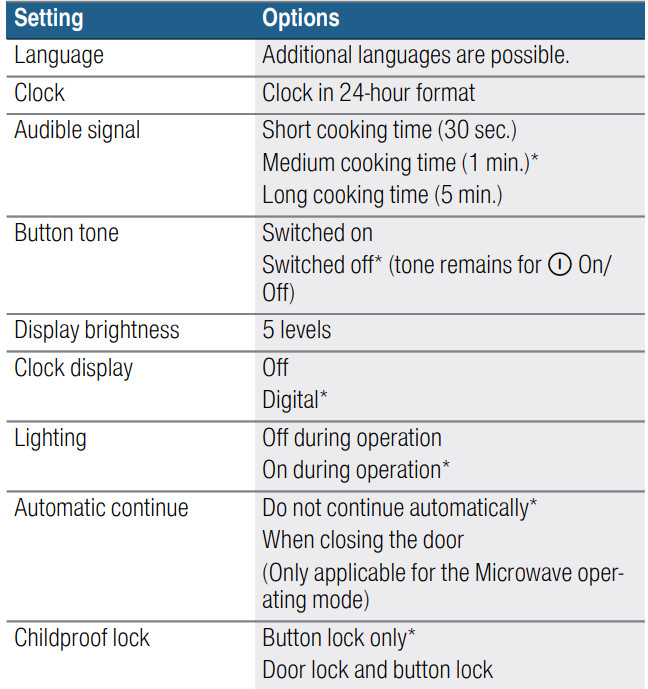
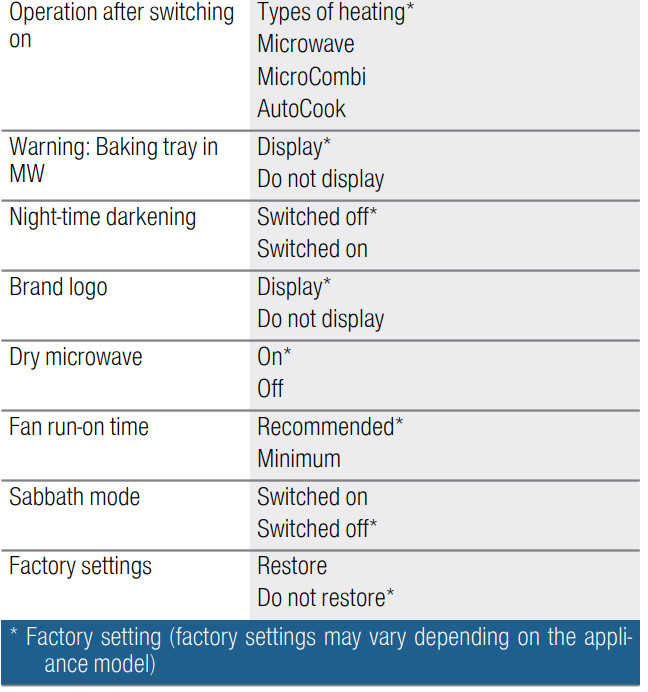
Note: Changes to the language, button tone and display brightness settings take effect immediately. All other changes take effect after the settings have been changed.
Power cut
The changes you make to the settings are saved even after a power cut. You only have to reset the settings for the initial use following a long-term power cut. The appliance can bridge a short-term power cut.
Changing the time
If you want to change the time, for example from summer to winter time, you have to change the basic setting. The appliance must be switched off.
- Touch the
 field for approx. 3 seconds. Notes on the process appear on the display.
field for approx. 3 seconds. Notes on the process appear on the display. - Press the
 field to confirm the notes. The first setting "language" appears in the display.
field to confirm the notes. The first setting "language" appears in the display. - Touch the
 field. The setting for the clock appears.
field. The setting for the clock appears. - Turn the rotary selector to change the clock time.
- Press and hold the
 field for approx. 3 seconds to confirm the setting.
field for approx. 3 seconds to confirm the setting.
A note is shown on the display to confirm that the settings have been saved.
Cleaning agent
With good care and cleaning, your appliance will retain its appearance and remain fully functioning for a long time to come. We will explain here how you should correctly care for and clean your appliance.
Suitable cleaning agents
To ensure that the different surfaces are not damaged by using the wrong cleaning agent, observe the information in the table. Depending on the appliance model, not all of the areas listed may be on/in your appliance.
Caution! Risk of surface damage
Do not use:
- Harsh or abrasive cleaning agents,
- Cleaning agents with a high alcohol content,
- Hard scouring pads or cleaning sponges,
- High-pressure cleaners or steam cleaners,
- Special cleaners for cleaning the appliance while it is hot.
Wash new sponge cloths thoroughly before use.
Tip: Highly recommended cleaning and care products can be purchased through the after-sales service. Observe the respective manufacturer's instructions.
Warning – Risk of burns!
The appliance becomes very hot. Never touch the interior surfaces of the cooking compartment or the heating elements. Always allow the appliance to cool down. Keep children at a safe distance.
Area & Cleaning
Appliance exterior
- Stainless steel front
- Hot soapy water: Clean with a dish cloth and then dry with a soft cloth. Remove flecks of limescale, grease, starch and albumin (e.g. egg white) immediately.
- Corrosion can form under such flecks. Special stainless steel cleaning products suitable for hot surfaces are available from our after-sales service or from specialist retailers. Apply a very thin layer of the cleaning product with a soft cloth.
- Plastic
- Hot soapy water: Clean with a dish cloth and then dry with a soft cloth. Do not use glass cleaner or a glass scraper.
- Painted surfaces
- Hot soapy water: Clean with a dish cloth and then dry with a soft cloth.
- Control panel
- Hot soapy water: Clean with a dish cloth and then dry with a soft cloth. Do not use glass cleaner or a glass scraper.
- Door panels
- Hot soapy water: Clean with a dish cloth and then dry with a soft cloth. Do not use a glass scraper or a stainless steel scouring pad.
- Door handle
- Hot soapy water: Clean with a dish cloth and then dry with a soft cloth. If descaler comes into contact with the door handle, wipe it off immediately. Otherwise, any stains will not be able to be removed.
Appliance interior
- Enamelled surfaces
- Hot soapy water or a vinegar solution: Clean with a dish cloth and then dry with a soft cloth. Soften baked-on food remnants with a damp cloth and soapy water. Use stainless steel wire wool or oven cleaner to remove stubborn dirt.
- Caution! Never use oven cleaner in the cooking compartment when it is still warm. This may damage the enamel. Remove all food remnants from the cooking compartment and the appliance door before you next heat up the appliance. Leave the cooking compartment open to dry after cleaning it.
- Note: Food residues can cause white deposits to form. These are harmless and do not affect how the appliance works. Remove using lemon juice if required.
- Glass cover for the interior lighting
- Hot soapy water: Clean with a dish cloth and then dry with a soft cloth. If the cooking compartment is heavily soiled, use oven cleaner.
- Door seal Do not remove.
- Hot soapy water: Clean with a dish cloth. Do not scour.
- Door cover
- made from stainless steel: Use stainless steel cleaner. Follow the manufacturers' instructions. Do not use stainless steel care products. made from plastic: Clean using hot soapy water and a dish cloth. Dry with a soft cloth. Do not use glass cleaner or a glass scraper. Remove the door cover for cleaning.
- Stainless steel interior door frame
- Stainless steel cleaner: Observe the manufacturer's instructions. This can be used to remove discolouration. Do not use stainless steel care products.
- Rails
- Hot soapy water: Soak and clean with a dish cloth or brush.
- Pull-out system
- Hot soapy water: Clean with a dish cloth or a brush. Do not remove the lubricant while the pull-out rails are pulled out – it is best to clean them when they are pushed in. Do not clean in the dishwasher.
- Accessories
- Hot soapy water: Soak and clean with a dish cloth or brush. If there are heavy deposits of dirt, use a stainless steel scouring pad.
Notes
- Slight differences in colour on the front of the appliance are caused by the use of different materials, such as glass, plastic and metal.
- Shadows on the door panels, which look like streaks, are caused by reflections made by the interior lighting.
- Enamel is baked on at very high temperatures.This can cause some slight colour variation. This is normal and does not affect operation. The edges of thin trays cannot be completely enamelled. As a result, these edges can be rough. This does not impair the anti-corrosion protection.
Keeping the appliance clean
Always keep the appliance clean and remove dirt immediately so that stubborn deposits of dirt do not build up.
Warning – Risk of fire! Loose food remnants, fat and meat juices may catch fire. Before using the appliance, remove the worst of the food remnants from the cooking compartment, heating elements and accessories.
Tips
- Clean the cooking compartment after each use. This will ensure that dirt cannot be baked on.
- Always remove flecks of limescale, grease, starch and albumin (e.g. egg white) immediately.
- Use the universal pan for baking very moist cakes.
- Use suitable ovenware for roasting, e.g. a roasting dish.
Rails
With good care and cleaning, your appliance will retain its appearance and remain fully functional for a long time to come. This will tell you how to remove the shelves and clean them.
Detaching and refitting the rails
Warning – Risk of burns! The rails become very hot. Never touch the hot rails. Always allow the appliance to cool down. Keep children away from the appliance.
Detaching the rails
- Push the rail to the front and up (fig 1)
- and detach it (fig. 2).
- Then swing the entire rail outwards ‚ and detach it at the rear b (fig. 3).
Clean the rails with cleaning agent and a sponge. For stubborn deposits of dirt, use a brush.
Inserting the holders
If the holders fall out when you remove the rails, these must be re-inserted.
- The holders at the front differ from those at the rear (fig. 1).
- Use the hook to mount the front holder at the top into the round hole a, set it at a slight incline, attach it at the bottom, and straighten it b(fig. 2).
- Use the hook to attach the rear holder into the upper hole a‚ and push it into the lower hole b (fig. 3).
Attaching the rails
When hanging the rails, ensure that the sloping edge is at the top of the rail.
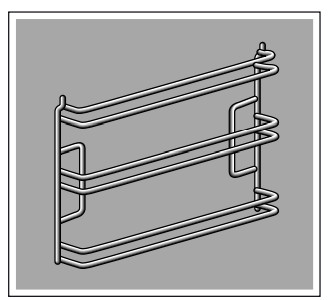
The rails fit both the left and right sides.
- Hold the rear of the frame at an angle, and mount it at the top and bottom a‚ (fig. 1).
- Pull the rail forwards (fig. 2).
- Then fold it forwards and insert it (fig. 3)
- and push it downwards (fig. 4).
Trouble shooting
Rectifying faults yourself
You can often easily rectify technical faults on the appliance yourself. If a dish does not turn out exactly as you wanted, you can find many tips and instructions for preparation at the end of the operating manual. ~ "Tested for you in our cooking studio" on page 29
Fault, Possible cause & Notes/remedy
- The appliance does not work.
- Faulty fuse.
- Check the circuit breaker in the fuse box.
- Power cut
- Check whether the kitchen light or other kitchen appliances are working
- Faulty fuse.
- "Sprache Deutsch" appears on the display.
- Power cut
- Reset the language and the time.
- Power cut
- The time does not appear when the appliance is switched off.
- Basic setting is changed.
- Change the basic setting for the clock display.
- Basic setting is changed.
- The appliance does not heat up; the
 symbol lights up on the display
symbol lights up on the display- Demo mode is activated in the basic settings.
- Briefly disconnect the appliance from the mains (switch off the circuit breaker in the fuse box) and then deactivate demo mode in the basic settings within 3 minutes.
- Demo mode is activated in the basic settings.
- The appliance will not start and "Cooking compartment too hot" appears on the display
- The cooking compartment is too hot for the selected dish or type of heating
- Allow the cooking compartment to cool down and start again
- The cooking compartment is too hot for the selected dish or type of heating
- The rotary selector has fallen out of the support in the control panel.
- The rotary selector has been accidentally disengaged.
- The rotary selector can be removed. Simply place the rotary selector back in its support in the control panel and push it in so that it engages and can be turned as usual.
- The rotary selector has been accidentally disengaged.
- The rotary selector can no longer be turned easily
- There is dirt under the rotary selector.
- The rotary selector can be removed. To disengage the rotary selector, simply remove it from the support. Alternatively, press on the outer edge of the rotary selector so that it tips and can be picked up easily. Carefully clean the rotary selector and its support on the appliance using a cloth and soapy water. Dry with a soft cloth. Do not use any sharp or abrasive materials. Do not soak or clean in the dishwasher. Do not remove the rotary selector too often so that the support remains stable.
- There is dirt under the rotary selector.
- The cooking compartment becomes hot during microwave-only operation
- Drying function is switched on.
- To prevent condensation forming when the appliance is in microwave-only mode, the appliance will automatically switch on the top heating element when it is set to 600 W or "Max.". The cooking result is not affected by this. You can switch this function off in the basic settings. Observe the information on the microwave. ~ "Microwave" on page 18
- Drying function is switched on.
Warning – Risk of injury!
Incorrect repairs are dangerous. Do not attempt to repair the appliance yourself. Repairs must only be carried out by one of our trained after-sales engineers. If the appliance is defective, call the after-sales service.
Warning – Risk of electric shock!
Incorrect repairs are dangerous. Repairs may only be carried out and damaged power cables replaced by one of our trained after-sales technicians. If the appliance is defective, unplug the appliance from the mains or switch off the circuit breaker in the fuse box. Contact the after-sales service.
Error messages on the display
When an error message appears on the display with "D" or "E", e.g. D0111 or E0111, switch the appliance off and on again using the On/Off button.
If it was a one-off error, the display goes out. If the error message appears again, call the after-sales service and quote the exact error message.
Maximum operating time
If you do not change the settings on your appliance for several hours, the appliance stops heating up automatically. This prevents unwanted continuous operation. The respective settings for the operating mode govern when the maximum operating time is reached.
Maximum operating time reached
A note appears on the display confirming that the maximum operating time has been reached. To continue operation, touch any field or turn the rotary selector. Switch the appliance off using the  On/Off button if you do not need to use it.
On/Off button if you do not need to use it.
Tip: Set a cooking time so that the appliance does not switch off when you do not want it to, e.g. with an extremely long preparation time. The appliance heats up until the set cooking time has elapsed.
Cooking compartment bulbs
To light the interior of your cooking compartment, your appliance has one or more long-life LED bulbs. However, if ever an LED bulb or the bulb's glass cover is defective, call the after-sales service. The lamp cover must not be removed.
See other models: CMG656RS1A CSG656RS1A HBF113BR0A HBF133BS0A HBA13B253A
